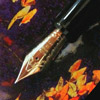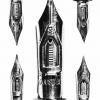Search the Community
Showing results for tags 'qin shi huang'.
-
Trying to decide if I should contact the seller about this. My Qin Shi Huang is more like the light purple Herbin Larmes de Cassis than it is a terra cotta, intense pink, or red (as it seems advertised). There's about 3mm of stuff that settles out within a day that is more of a brick red, sorta clog...
- 10 replies
-
- qin shi huang
- noodlers
-
(and 1 more)
Tagged with:
-
Noodler's Qin Shi Huang Review & Election Week Giveaway Note: Note: this review is also available on my personal reviews site with more pictures and better formatting. If you'd like to take a look, click here. The giveaway is also only available through that site. Click here for more details...
- 6 replies
-
- noodlers
- qin shi huang
-
(and 1 more)
Tagged with:
-
Here's a very unique ink from Noodler's named after the first emperor of China. It's slightly on the acidic side (while most every other Noodler's ink has a neutral pH), and meant to look like terra-cotta (I suppose; it seems too bright for that to me). It also glows under UV, but isn't terribly dra...
- 3 replies
-
- noodlers qin shi huang
- red ink
- (and 6 more)





